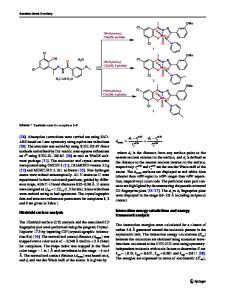Theoretical Studies of Structures of Vanadate Complexes in Aqueous Solution
Effects of thermal motion and interaction with a solvent on NMR chemical shifts of transition-metal complexes are studied with an approach based on molecular dynamics simulations and averaging of magnetic shieldings computed for snapshots along the trajec
- PDF / 1,696,792 Bytes
- 11 Pages / 439 x 666 pts Page_size
- 82 Downloads / 272 Views
Abstract. Effects of thermal motion and interaction with a solvent on NMR chemical shifts of transition-metal complexes are studied with an approach based on molecular dynamics simulations and averaging of magnetic shieldings computed for snapshots along the trajectory. In some cases, for instance for iron cyanide complexes, large effects on the metal shielding are revealed, which can be traced back to changes in mean bond distances upon dynamical averaging in aqueous solution. For vanadate complexes in water, the effects are less pronounced, and amount to a few dozen ppm, irrespective of the density functional employed. The shielding of the 51 V resonance on going from the parent vanadate to peroxovanadate complexes is not reproduced in the simulations. The dynamics of a peroxovanadium-imidazole complex, a model compound for biomimetic oxidants, is studied in the gas phase and in water. In the pristine complex, rapid rotation of the imidazole ligand about the V-N bond occurs on the picosecond timescale. This complex does not coordinate hydrogen peroxide at vanadium. The implications for a possible mechanism of the oxidation reactions are discussed.
1 Introduction Ever since the quantum-chemical computations of NMR chemical shifts became routinely feasible, they proved to be powerful probes for electronic and geometrical structure [1]. Ongoing progress in methodology and computer hardware allows the treatment of ever more complex and demanding systems, such as transition-metal complexes [2]. Important current developments are aimed at going beyond the treatment of substrates as vibrationless molecules at absolute zero and at allowing for specific interactions with the surrounding solvent. Both aspects can be addressed with molecular dynamics (MD) simulations by way of averaging magnetic shieldings computed for snapshots along the trajectory. This procedure has been pioneered by combining classical MD with quantum-chemical NMR computations in order to modcl the gas-to-liquid shift of 17 0 in water [3]. Recently, we have extended this approach to assess thermal and solvent effects on transition-metal chemical S. Wagner et al. (eds.), High Performance Computing in Science and Engineering, Munich 2002 © Springer-Verlag Berlin Heidelberg 2003
190
M. Buhl, F.T. Mauschick, R. Schurhammer
shifts and have obtained interesting insights into the structure and dynamics of the solvation shells in aqueous vanadate systems [4]. The present paper describes recent progress that has been made in this area, and is organized as follows: Firstly, we give a brief general description of the methods that are being employed, followed by a discussion of the results for iron cyanide complexes and for peroxovanadium species in aqueous solution.
2 Methods Central to the dynamical averaging of properties are density-functional based Car-Parrinello MD (CPMD) [5] simulations of the metal complexes, both in vacuo and in aqueous solution. In these simulations, periodic boundary conditions, suitable pseudopotentials and plane-wave basis sets a
Data Loading...











